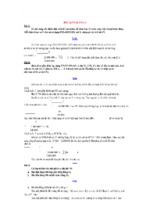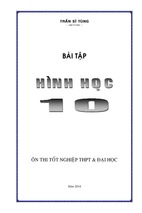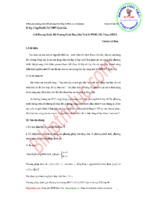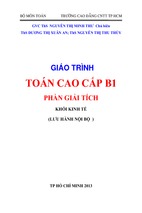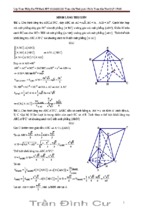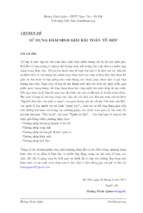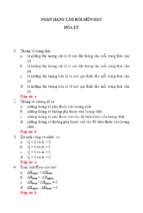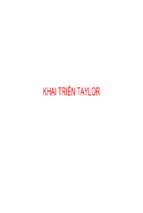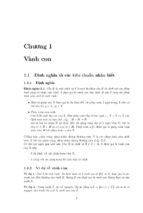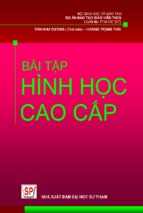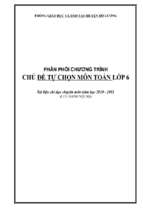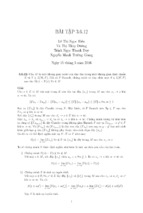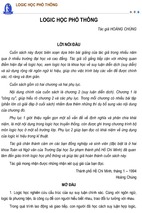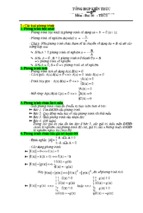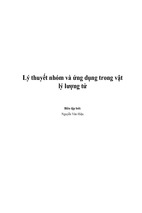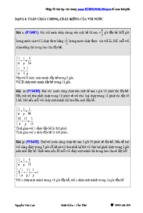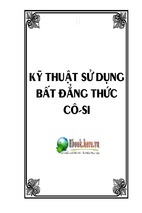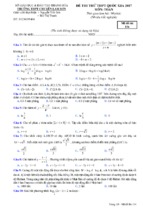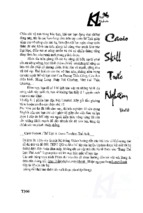The Art of the Infinite
The Tower of Mathematics is the Tower of Babel inverted: its voices grow more
coherent as it rises. The image of it is based on Pieter Brueghel’s “Little Tower of
Babel” (1554).
The Art of the Infinite:
The Pleasures of Mathematics
Robert Kaplan and Ellen Kaplan
Illustrations by Ellen Kaplan
2003
Oxford New York
Auckland Bangkok Buenos Aires Cape Town Chennai
Dar es Salaam Delhi Hong Kong Istanbul Karachi Kolkata
Kuala Lumpur Madrid Melbourne Mexico City Mumbai Nairobi
São Paulo Shanghai Taipei Tokyo Toronto
Copyright © 2003 by Robert Kaplan and Ellen Kaplan
Published by Oxford University Press, Inc.
198 Madison Avenue, New York, New York 10016
www.oup-usa.org
Oxford is a registered trademark of Oxford University Press
All rights reserved. No part of this publication may be reproduced,
stored in a retrieval system, or transmitted, in any form or by any means,
electronic, mechanical, photocopying, recording, or otherwise,
without the prior permission of Oxford University Press.
Library of Congress Cataloging-in-Publication Data
is available
ISBN-0-19-514743-X
Also by Robert Kaplan
The Nothing That Is: A Natural History of Zero
135798642
Printed in the United States of America
on acid-free paper
For Michael, Jane, and Felix
This page intentionally left blank
Contents
Acknowledgments
ix
An Invitation
1
Chapter One
Time and the Mind
3
Chapter Two
How Do We Hold These Truths?
29
Chapter Three
Designs on a Locked Chest
56
Interlude
The Infinite and the Indefinite
75
Chapter Four
Skipping Stones
77
Chapter Five
Euclid Alone
100
Interlude
Longing and the Infinite
131
vii
The Art of the Infinite
Chapter Six
The Eagle of Algebra 133
Chapter Seven
Into the Highlands
167
Interlude
The Infinite and the Unknown 200
Chapter Eight
Back of Beyond
202
Chapter Nine
The Abyss 228
Appendix 263
Bibliography 315
Index 317
viii
Acknowledgments
We have been unusually fortunate in our readers, who from four different perspectives brought our book into focus. Jean Jones, Barry Mazur,
John Stillwell, and Jim Tanton put a quantity of time and quality of
thought into their comments, which made the obscure transparent and
the crooked straight. We are very grateful.
The community of mathematicians is more generous than most. Our
thanks to all who have helped, with special thanks to Andrew Ranicki
and Paddy Patterson.
No one could ask for better people to work with than Eric Simonoff
and Cullen Stanley of Janklow & Nesbit, who make the gears that turn
writing into reading mesh with ease; nor a better, more thoughtful editor than Peter Ginna, in whom all the best senses of wit unite.
ix
This page intentionally left blank
The Art of the Infinite
This page intentionally left blank
An Invitation
∞
An Invitation
Less than All cannot satisfy Man.
—William Blake
We commonly think of ourselves as little and lost in the infinite stretches
of time and space, so that it comes as a shock when the French poet
Baudelaire speaks of “cradling our infinite on the finite seas.” Really? Is
it ourself, our mind or spirit, that is infinity’s proper home? Or might
the infinite be neither out there nor in here but only in language, a pretty
conceit of poetry?
We are the language makers, and what we express always refers to
something—though not, perhaps, to what we first thought it did. Talk
of the infinite naturally belongs to that old, young, ageless conversation
about number and shape which is mathematics: a conversation most of
us overhear rather than partake in, put off by its haughty abstraction.
Mathematics promises certainty—but at the cost, it seems, of passion.
Its initiates speak of playfulness and freedom, but all we come up against
in school are boredom and fear, wedged between iron rules memorized
without reason.
Why hasn’t mathematics the gentle touches a novelist uses to lure the
reader into his imagination? Why do we no longer find problems like
this, concocted by Mah~v§r~ in ninth-century India:
One night, in a month of the spring season, a certain young lady
was lovingly happy with her husband in a big mansion, white as
the moon, set in a pleasure garden with trees bent down with flowers and fruits, and resonant with the sweet sounds of parrots, cuckoos and bees which were all intoxicated with the honey of the
flowers. Then, on a love-quarrel arising between husband and wife,
her pearl necklace was broken. One third of the pearls were collected by the maid-servant, one sixth fell on the bed—then half of
1
The Art of the Infinite
what remained and half of what remained thereafter and again one
half of what remained thereafter and so on, six times in all, fell
scattered everywhere. 1,161 pearls were still left on the string; how
many pearls had there been in the necklace?
Talking mostly to each other or themselves, mathematicians have developed a code that is hard to crack. Its symbols store worlds of meaning
for them, its sleek equations leap continents and centuries. But these
sparks can jump to everyone, because each of us has a mind built to
grasp the structure of things. Anyone who can read and speak (which
are awesomely abstract undertakings) can come to delight in the works
of mathematical art, which are among our kind’s greatest glories.
The way in is to begin at the beginning and move conversationally
along. Eccentric, lovable, laughable, base, and noble mathematicians will
keep us company. Each equation in a book, Stephen Hawking once remarked, loses half the potential readership. Our aim here, however, is to
let equations—those balances struck between two ways of looking—
grow organically from what they look at.
Many small things estrange math from its proper audience. One is
the remoteness of its machine-made diagrams. These reinforce the mistaken belief that it is all very far away, on a planet visited only by graduates
of the School for Space Cadets. Diagrams printed out from computers
communicate a second and subtler falsehood: they lead the reader to
think he is seeing the things themselves rather than pixellated approximations to them.
We have tried to solve this problem of the too far and the too near by
putting our drawings in the human middle distance, where diagrams
are drawn by hand. These reach out to the ideal world we can’t see from
the real world we do, as our imagination reaches in turn from the shaky
circle perceived to the conception of circle itself.
Fuller explanations too will live in the middle distance: some in the
appendix, others—the more distant excursions—(along with notes to
the text) in an on-line Annex, at www.oup-usa.org/artoftheinfinite.
Gradually, then, the music of mathematics will grow more distinct.
We will hear in it the endless tug between freedom and necessity as playful inventions turn into the only way things can be, and timeless laws are
drafted—in a place, at a time, by a fallible fellow human. Just as in listening to music, our sense of self will widen out toward a more than
personal vista, vivid and profound.
Whether we focus on the numbers we count with and their offspring
or the shapes that evolve from triangles, ever richer structures will slide
into view like beads on the wire of the infinite. And it is this wire, running throughout, that draws us on, until we stand at the edge of the
universe and stretch out a hand.
2
Time and the Mind
∞
one
Time and the Mind
Things occupy space—but how many of them there are (or could be)
belongs to time, as we tick them off to a walking rhythm that projects
ongoing numbering into the future. Yet if you take off the face of a clock
you won’t find time there, only human contrivance. Those numbers,
circling round, make time almost palpable—as if they aroused a sixth
sense attuned to its presence, since it slips by the usual five (although
aromas often do call up time past). Can we get behind numbers to find
what it is they measure? Can we come to grips with the numbers themselves to know what they are and where they came from? Did we discover or invent them—or do they somehow lie in a profound crevice
between the world and the mind?
Humans aren’t the exclusive owners of the smaller numbers, at least.
A monkey named Rosencrantz counts happily up to eight. Dolphins and
ferrets, parrots and pigeons can tell three from five, if asked politely.
Certainly our kind delights in counting from a very early age:
One potato, two potato, three potato, four;
Five potato, six potato, seven potato, more!
Not that the children who play these counting-out games always get
it right:
Wunnery tooery tickery seven
Alibi crackaby ten eleven
Pin pan musky Dan
Tweedle-um twoddle-um twenty-wan
Eerie orie ourie
You are out!
This is as fascinating as it is wild, because whatever the misconceptions about the sequence of counting numbers (alibi and crackaby may
3
The Art of the Infinite
be eight and nine, but you’ll never get seven to come right after tickery),
the words work perfectly well in counting around in a circle—and it’s
always the twenty-first person from the start of the count who is out, if
“you” and “are” still act as numerals as they did in our childhood. We
can count significantly better than rats and raccoons because we not
only recognize different magnitudes but
know how to match up separate things with the successive
numbers of a sequence:
a little step, it seems, but one which will take us beyond the moon.
The first few counting numbers have puzzlingly many names from
language to language. Two, zwei, dva, and deux is bad enough, even without invoking the “burla” of Queensland Aboriginal or the Mixtec “ùù”.
If you consult just English-speaking children, you also get “twa”,“dicotty”,
“teentie”, “osie”, “meeny”, “oarie”, “ottie”, and who knows how many others. Why is this playful speciation puzzling? Because it gives very local
embodiments to what we think of as universal and abstract.
Not only do the names of numbers vary, but, more surprisingly, how
we picture them to ourselves. Do you think of “six” as
or
or
or
or
?
A friend of ours, whose art is the garden, has since childhood always
imagined the numbers as lying on a zigzag path:
What happens, however, if we follow Isobel’s route past 60? It continues into the blue on a straight line. Almost everyone lets the idiosyncrasies go somewhere before a hundred, as not numbers but Number recedes
into the distance. 3 and 7, 11 and 30 will have distinct characters and
magical properties, perhaps, for many—but is 65,537 anyone’s lucky
number? What makes mathematics so daunting from the very start is
4
Time and the Mind
how its atoms accelerate away. A faceless milling crowd has elbowed out
the kindly nursery figures. Its sheer extent and anonymity alienate our
humanity, and carry us off (as Robert Louis Stevenson once put it) to
where there is no habitable city for the mind of man.
We can reclaim mathematics for ourselves by going back to its beginnings: the number one. Different as its names may be from country to
country or the associations it has for you and me, its geometric representation is unambiguous: • . The notion of one—one partridge, a pear
tree, the whole—feels too comfortable to be anything but a sofa in the
living-room of the mind.
Almost as familiar, like a tool whose handle has worn to the fit of a
hand, is the action of adding. We take in “1 + 1”, as a new whole needing
a new name, so easily and quickly that we feel foolish in trying to define
what addition is. Housman wrote:
To think that two plus two are four
And neither five nor three
The heart of man has long been sore
And long ’tis like to be.
Perhaps. But the head has long been grateful for this small blessing.
With nothing more than the number one and the notion of adding,
we are on the brink of a revelation and a mystery. Rubbing those two
sticks together will strike the spark of a truth no doubting can ever extinguish, and put our finite minds in actual touch with the infinite. Ask
yourself how many numbers there are; past Isobel’s 60, do they come to
a halt at 65,537 or somewhere out there, at the end of time and space?
Say they do; then there is a last number of all—call it n for short. But
isn’t n + 1 a number too, and even larger? So n can’t have been the last—
there can’t be a last number.
There you are: a proof as profound, as elegant, as imperturbable as
anything in mathematics. You needn’t take it on faith; you need neither
hope for nor fear it, but know with all the certainty of reason that the
counting numbers can’t end. If you are willing to put this positively and
say: there are infinitely many counting numbers—then all those differences between the small numbers you know, and the large numbers you
don’t, shrink to insignificance beside this overwhelming insight into their
totality.
This entente between 1 and addition also tells you something important about each point in the array that stretches, like Banquo’s descendants, even to the crack of doom. Every one of these counting numbers
is just a sum of 1 with itself a finite number of times: 1 + 1 + 1 + 1 + 1 =
5, and with paper and patience enough, we could say that the same is
true of 65,537.
5
The Art of the Infinite
These two truths—one about all the counting numbers, one about
each of them—are very different in spirit, and taken together say something about how peculiar the art of mathematics is. The same technique
of merely going on adding 1 to itself shows you, on the one hand, how
each of the counting numbers is built—hence where and what each one
is; on the other, it tells you a dazzling truth about their totality that overrides the variety among them. We slip from the immensely concrete to
the mind-bogglingly abstract with the slightest shift in point of view.
∞
Armies of Unalterable Law
Does number measure time, or does time measure number? And in one
case or both, have we just proven that ongoing time is infinite? Like those
shifts from the concrete to the abstract, mathematics also alternates
minute steps with gigantic leaps, and to make this one we would have to
go back to what seemed no more than a mere form of words. We asked if
you were willing to recast our negative result (the counting numbers
never end) positively: there are infinitely many counting numbers. To
put it so seems to summon up an infinite time through which they are
iterated. But are we justified in taking this step?
To speak with a lawyerly caution, we showed only that if someone
claimed there was a last number we could prove him wrong by generating—in time—a next. Were we to turn our positive expression into a
spatial image we might conjure up something like a place where all the
counting numbers, already generated, lived—but this is an image only,
and a spatial image, for a temporal process at that. Might it not be that
our proof shows rather that our imaging is always firmly anchored to
present time, on whose moving margin our thought is able to make (in
time) a next counting number—but with neither the right, ability, nor
need to conjure up their totality all at once? The tension between these
two points of view—the potentially infinite of motion and the actual
infinity of totality—continues today, unresolved, opening up fresh approaches to the nature of mathematics. The uneasy status of the infinite
will accompany us throughout this book as we explore, return with our
trophies, and set out again.
Here is the next truth. We can see that the sizable army of counting
numbers needs to be put in some sort of order if we are to deploy it. We
could of course go on inventing new names and new symbols for the
numbers as they spill out: why not follow one, two, three, four, five, six,
seven, eight, and nine with kata, gwer, nata, kina, aruma (as the Oksapmin
of Papua New Guinea do, after their first nine numerals, which begin:
6
Time and the Mind
tipna, tipnarip, bumrip . . .)? And surely the human mind is sufficiently
fertile and memory flexible enough to avoid recycling old symbols and
follow 7, 8, and 9 with @, ¤, β—dare we say and so on?
The problem isn’t a lack of imagination but the need to calculate with
these numbers. We might want to add 8 and 9 and not have to remember a fanciful squiggle for their sum. The great invention, some five thousand years ago, of positional notation brought the straggling line of
counting numbers into squadrons and regiments and battalions. After a
conveniently short run of new symbols from 1 (for us this run stops at
9), use 1 again for the next number, but put it in a new column to the left
of where those first digits stood. Here we will keep track of how many
tens we have. Then put a new symbol, 0, in the digits’ column to show we
have no units. You can follow 10 with 11, 12 and so on, meaning (to its
initiates) a ten and one more, two more, . . . Continue these columns on,
ever leftward, after 99 exhausts the use of two columns and 999 the use
of three. Our lawyer from two paragraphs ago would remind us that
those columns weren’t “already there” but constructed when needed.
65,537, for example, abbreviates
ten thousands
6
thousands
5
hundreds
5
tens units
3
7 .
As always in mathematics, great changes begin off-handedly, the way
important figures in Proust often first appear in asides. Zero was only a
notational convenience, but this nothing, which yet somehow is, gave a
new depth to our sense of number, a new dimension—as the invention
of a vanishing point suddenly deepened the pictorial plane of Renaissance art (a subject to which we shall return in Chapter Eight).
But is zero a number at all? It took centuries to free it from sweeping
the hearth, a humble punctuation mark, and find that the glass slipper
fitted it perfectly. For no matter how convenient a notion or notation is,
you can’t just declare it to be a number among numbers. The deep principle at work here—which we will encounter again and again—is that
something must not only act like a number but interact companionably
with other numbers in their republic, if you are to extend the franchise
to it.
This was difficult in the case of zero, for it behaved badly in company.
The sum of two numbers must be greater than either, but 3 + 0 is just 3
again. Things got no better when multiplication was in the air. 3 · 17 is
different from 4 · 17, yet 3 · 0 is the same as 4 · 0—in fact, anything times
0 is 0. This makes sense, of course, since no matter how many times you
add nothing to itself (and multiplication is just sophisticated addition,
isn’t it?), you still have nothing. What do you do when someone’s ser-
7
- Xem thêm -

